
APOGEE INSTRUMENTS, INC. | 721 WEST 1800 NORTH, LOGAN, UTAH 84321, USA
TEL: (435) 792-4700 | FAX: (435) 787-8268 | WEB: APOGEEINSTRUMENTS.COM
Copyright © 2022 Apogee Instruments, Inc.
OWNER’S MANUAL
PRI SENSORS
Models S2-421 and S2-422
Rev: 31-Aug-2022
Upward (model S2-421)
Downward (model S2-422)

TABLE OF CONTENTS
Owner’s Manual ............................................................................................................................................................................... 1
Certificates of Compliance ....................................................................................................................................................... 3
Introduction ............................................................................................................................................................................. 5
Sensor Models ......................................................................................................................................................................... 6
Specifications ........................................................................................................................................................................... 7
Deployment and Installation .................................................................................................................................................. 10
Cable Connectors ................................................................................................................................................................... 12
Operation and Measurement ................................................................................................................................................ 13
Maintenance and Recalibration ............................................................................................................................................. 18
Troubleshooting and Customer Support ................................................................................................................................ 19
Return and Warranty Policy ................................................................................................................................................... 20

CERTIFICATE OF COMPLIANCE
EU Declaration of Conformity
This declaration of conformity is issued under the sole responsibility of the manufacturer:
Apogee Instruments, Inc.
721 W 1800 N
Logan, Utah 84321
USA
for the following product(s):
Models: S2-421, S2-422
Type: PRI Sensors
The object of the declaration described above is in conformity with the relevant Union harmonization legislation:
2014/30/EU Electromagnetic Compatibility (EMC) Directive
2011/65/EU Restriction of Hazardous Substances (RoHS 2) Directive
2015/863/EU Amending Annex II to Directive 2011/65/EU (RoHS 3)
Standards referenced during compliance assessment:
EN 61326-1:2013 Electrical equipment for measurement, control, and laboratory use – EMC requirements
EN 63000:2018 Technical documentation for the assessment of electrical and electronic products with
respect to the restriction of hazardous substances
Please be advised that based on the information available to us from our raw material suppliers, the products
manufactured by us do not contain, as intentional additives, any of the restricted materials including lead (see
note below), mercury, cadmium, hexavalent chromium, polybrominated biphenyls (PBB), polybrominated
diphenyls (PBDE), bis (2-ethylhexyl) phthalate (DEHP), butyl benzyl phthalate (BBP), dibutyl phthalate (DBP), and
diisobutyl phthalate (DIBP). However, please note that articles containing greater than 0.1 % lead concentration
are RoHS 3 compliant using exemption 6c.
Further note that Apogee Instruments does not specifically run any analysis on our raw materials or end products
for the presence of these substances, but we rely on the information provided to us by our material suppliers.
Signed for and on behalf of:
Apogee Instruments, August 2022
Bruce Bugbee
President
Apogee Instruments, Inc.

CERTIFICATE OF COMPLIANCE
UK Declaration of Conformity
This declaration of conformity is issued under the sole responsibility of the manufacturer:
Apogee Instruments, Inc.
721 W 1800 N
Logan, Utah 84321
USA
for the following product(s):
Models: S2-421, S2-422
Type: PRI Sensors
The object of the declaration described above is in conformity with the relevant UK Statutory Instruments and
their amendments:
2016 No. 1091 The Electromagnetic Compatibility Regulations 2016
2012 No. 3032 The Restriction of the Use of Certain Hazardous Substances in Electrical and Electronic
Equipment Regulations 2012
Standards referenced during compliance assessment:
BS EN 61326-1:2013 Electrical equipment for measurement, control, and laboratory use – EMC requirements
BS EN 63000:2018 Technical documentation for the assessment of electrical and electronic products with
respect to the restriction of hazardous substances
Please be advised that based on the information available to us from our raw material suppliers, the products
manufactured by us do not contain, as intentional additives, any of the restricted materials including lead (see
note below), mercury, cadmium, hexavalent chromium, polybrominated biphenyls (PBB), polybrominated
diphenyls (PBDE), bis (2-ethylhexyl) phthalate (DEHP), butyl benzyl phthalate (BBP), dibutyl phthalate (DBP), and
diisobutyl phthalate (DIBP). However, please note that articles containing greater than 0.1 % lead concentration
are RoHS 3 compliant using exemption 6c.
Further note that Apogee Instruments does not specifically run any analysis on our raw materials or end products
for the presence of these substances, but we rely on the information provided to us by our material suppliers.
Signed for and on behalf of:
Apogee Instruments, August 2022
Bruce Bugbee
President
Apogee Instruments, Inc.

INTRODUCTION
Radiation reflected from surfaces (e.g., plant canopies, soil) provides information about the state of the surface.
Reflectance is the ratio of radiation reflected by the surface to radiation incident on the surface.
A common index calculated from reflectance measurements is photochemical reflectance index (PRI). PRI is
calculated from reflectance at 531 nm (green) and 570 nm (yellow) and provides an indication of canopy
photosynthetic activity.
The typical application of PRI sensors is monitoring plant canopies. PRI is related to plant canopy light use
efficiency and is often used in studies of canopy photosynthesis and response to stress.
Apogee Instruments S2 series two-band sensors consist of a cast acrylic diffuser (upward-looking sensor) or acrylic
window (downward-looking sensor), pair of photodiodes that measure specific wavelength ranges, signal
processing circuitry mounted in an anodized aluminum housing, and a cable to connect the sensor to a
measurement device. S2 series sensors are designed for continuous irradiance (upward-looking sensor) or radiance
(downward-looking sensor) measurements in indoor and outdoor environments. Reflectance derived from paired
upward-looking and downward-looking sensors can be used to calculate PRI.

SENSOR MODELS
This manual covers SDI-12 output models S2-421 and S2-422 (in bold below). Additional models are covered in
their respective manuals.
Model
Signal
Description
S2-121
Voltage
Measures green and yellow irradiance (upward- looking ) for PRI
S2-122
Voltage
Measures green and yellow irradiance (downward- looking ) for PRI
S2-421
SDI-12
Measures green and yellow irradiance (upward- looking ) for PRI
S2-422
SDI-12
Measures green and yellow irradiance (downward- looking ) for PRI
Upward-looking (S2-421) sensor model number and
serial number are located on the bottom of the
sensor. If you need the manufacturing date of your
sensor, please contact Apogee Instruments with the
serial number of your sensor.
Downward-looking (S2-422) sensor model number
and serial number are located near the connector
on the sensor cable. If you need the manufacturing
date of your sensor, please contact Apogee
Instruments with the serial number of your sensor.

SPECIFICATIONS
Calibration Traceability
Apogee S2 series PRI sensors are calibrated through side-by-side comparison to the mean of three transfer
standard sensors under a quartz halogen lamp. The transfer standard PRI sensors are calibrated through side-by-
side comparison to the mean of six replicate direct and diffuse solar spectra collected in Logan, Utah, using an
Apogee PS-300 spectroradiometer. The Apogee PS-300 spectroradiometer is calibrated with a quartz halogen lamp
traceable to the National Institute of Standards and Technology (NIST).
PRI
S2-421-SS
(upward-looking)
S2-422-SS
(downward-looking)
Calibration Factor
(reciprocal of
sensitivity)**
Custom for each sensor and stored in firmware
Calibration Uncertainty
± 5 %
Output Range**
SDI-12
Power Supply
5.5 to 24 V DC
Wavelength Ranges
Green detector = 532 nm with 10 nm FWHM*
Yellow detector = 570 nm with 10 nm FWHM*
Measurement Range
2x full sunlight
Measurement
Repeatability
Less than 1 %
Long-term Drift
Less than 2 % per year
Response Time
Less than 0.6 s
Field of View
180°
35°
Directional (Cosine)
Response
± 2 % at 45°, ± 5 % at 75° zenith angle
Temperature Response
Less than 0.1 % per C
Housing
Anodized aluminum body with acrylic diffuser
IP Rating
IP68
Operating Environment
-40 to 70 C; 0 to 100 % relative humidity
Dimensions
30.5 mm diameter, 37 mm height
23.5 mm diameter,
43 mm height
Mass (with 5 m of cable)
140 g
110 g
Cable
5 m of shielded, twisted-pair wire; TPR jacket (high water resistance, high UV stability, flexibility
in cold conditions); pigtail lead wires; stainless steel (316), M8 connector
*FWHM = full-width half-maximum
** The Calibration Factor (reciprocal of sensitivity) and Output Range are all approximations and variable from sensor to
sensor

Cosine Response
Upward- and Downward-looking Two-band Sensors
Directional, or cosine, response is defined as
the measurement error at a specific angle of
radiation incidence. Error for Apogee S2
series PRI sensors is approximately ± 2 % and
± 5 % at solar zenith angles of 45° and 75°,
respectively.
Upward (model S2-421)
Downward (model S2-422)

Spectral Response Graph of PRI
The PRI sensors have the spectral
ranges of 532 nm with 10 nm full-
width half-maximum (Green) and 570
nm with 10 nm full-width half-
maximum (Yellow). The spectral
responses can be seen in the graph to
the left.

DEPLOYMENT AND INSTALLATION
Mount the upward-looking sensor to a solid surface with the nylon mounting screw provided to prevent galvanic
corrosion. To accurately measure irradiance incident on a horizontal surface, the sensor must be level. An Apogee
Instruments model AL-100 Leveling Plate is recommended to level the sensor when used on a flat surface or being
mounted to surfaces such as wood. To facilitate mounting on a mast or pipe, the Apogee Instruments model AL-
120 Solar Mounting Bracket with AL-100 Leveling Plate is recommended.
To minimize azimuth error, the sensor should be mounted with the cable pointing toward true north in the
northern hemisphere or true south in the southern hemisphere. Azimuth error is typically less than 1 %, but it is
easy to minimize by proper cable orientation.
In addition to orienting the cable to point toward the nearest pole, the sensor should also be mounted such that
obstructions (e.g., weather station tripod/tower or other instrumentation) do not shade the sensor. Once
mounted, the black cap should be removed from the sensor. The green cap can be used as a protective covering
for the sensor when it is not in use.
Nylon Screw: 10-32x3/8
Nylon Screw: 10-32x3/8
Model AL-120
Model AL-100

Downward-looking sensor mounting
Mount the sensor to a solid surface with the nylon mounting screw provided to prevent galvanic corrosion. To
facilitate mounting on a mast or pipe, the Apogee Instruments model SM-400 Two Band Radiometer Downward-
looking Mounting Bracket is recommended.

CABLE CONNECTORS
Apogee sensors offer cable connectors to simplify
the process of removing sensors from weather
stations for calibration (the entire cable does not
have to be removed from the station and shipped
with the sensor).
The ruggedized M8 connectors are rated IP68, made
of corrosion-resistant marine-grade stainless-steel,
and designed for extended use in harsh
environmental conditions.
Cable connectors are attached directly to the head.
Instructions
Pins and Wiring Colors: All Apogee connectors have
six pins, but not all pins are used for every sensor.
There may also be unused wire colors inside the
cable. To simplify datalogger connection, we remove
the unused pigtail lead colors at the datalogger end
of the cable.
If a replacement cable is required, please contact
Apogee directly to ensure ordering the proper pigtail
configuration.
Alignment: When reconnecting a sensor, arrows on
the connector jacket and an aligning notch ensure
proper orientation.
Disconnection for extended periods: When
disconnecting the sensor for an extended period of
time from a station, protect the remaining half of the
connector still on the station from water and dirt
with electrical tape or other method.
A reference notch inside the connector ensures
proper alignment before tightening.
When sending sensors in for calibration, only send the
sensor head.
Tightening: Connectors are designed to be firmly
finger-tightened only. There is an o-ring inside the
connector that can be overly compressed if a wrench
is used. Pay attention to thread alignment to avoid
cross-threading. When fully tightened, 1-2 threads
may still be visible.
WARNING: Do not tighten the connector by twisting
the black cable or sensor head, only twist the metal
connector (blue arrows).
Finger-tighten firmly

OPERATION AND MEASUREMENT
The S2-400 series two-band sensors have an SDI-12 output, where irradiance or radiance is returned in digital
format. Measurement of S2-400 series two-band sensors requires a measurement device with SDI-12 functionality
that includes the M or C command.
Wiring for S2-400 series
Reflectance and Reflectance Indices (PRI)
Reflectance (ρ) is the ratio of radiance, the calibrated signal returned by the downward-looking sensor, to
irradiance, the calibrated signal returned by the upward-looking sensor, for a specific wavelength range:
= radiance reflected from the surface / irradiance incident on the surface
Typically, a measurement of radiance is used in the numerator of the equation above to determine reflectance.
Theoretically, when ρ is determined from radiance reflected from the surface it is called directional reflectance,
which approximates the bidirectional reflectance factor. When ρ is determined from irradiance reflected from the
surface it is called hemispherical reflectance. Both terms are referred to as reflectance herein.
PRI is calculated as the difference between reflectance at 532 nm (green) and reflectance at 570 (yellow) divided
by the sum of these reflectances:
𝑃𝑅𝐼 = 𝜌𝐺𝑟𝑒𝑒𝑛 − 𝜌𝑌𝑒𝑙𝑙𝑜𝑤
𝜌𝐺𝑟𝑒𝑒𝑛 + 𝜌𝑌𝑒𝑙𝑙𝑜𝑤
It is important to ensure that paired upward-looing and downward-looking sensors make measurements at the
same time, otherwise temporal changes in sky conditions can result in errors in reflectance and calculated PRI
values.
A single upward-looking sensor can be deployed with multiple downward-looking sensors, and irradiance from the
single upward-looking sensor can be used to calculate PRI at the location of all the downward-looking sensors, if
the downward-looking sensors are in close proximity to each other (e.g., within a research plot).
An approximation of PRI can also be made using only measured radiances and a value of , but this is not
recommended because the difference between green and yellow radiances is small, resulting in high sensitivity of
the PRI approximation to the value of .
White: Output Signal
Red: Power in (4.5-24 V DC)
Black: Ground
Clear: Shield

Sensor Calibration
All Apogee SDI-12 S2 sensor models have sensor-specific calibration coefficients determined during the custom
calibration process. Coefficients are programmed into sensor microcontrollers at the factory.
SDI-12 Interface
The following is a brief explanation of the serial digital interface SDI-12 protocol instructions used in Apogee S2-
400 series PRI sensors. For questions on the implementation of this protocol, please refer to the official version of
the SDI-12 protocol: http://www.sdi-12.org/specification.php (version 1.4, August 10, 2016).
Overview
During normal communication, the data recorder sends a packet of data to the sensor that consists of an address
and a command. Then, the sensor sends a response. In the following descriptions, SDI-12 commands and
responses are enclosed in quotes. The SDI-12 address and the command/response terminators are defined as
follows:
Sensors come from the factory with the address of “0” for use in single sensor systems. Address “1 to 9” and “A
to Z,” or “a to z,” can be used for additional sensors connected to the same SDI-12 bus.
“!” is the last character of a command instruction. In order to be compliant with SDI-12 protocol, all commands
must be terminated with a “!”. SDI-12 language supports a variety of commands. Supported commands for the
Apogee Instruments S2-400 series two-band radiometers are listed in the following table (“a” is the sensor
address. The following ASCII Characters are valid addresses: “0-9” or “A-Z”). Please note that SDI-12 commands are
case-sensitive.
Supported Commands for Apogee Instruments S2-400 Series PRI Sensors
Instruction Name
Instruction Syntax
Description
Address Query Command
?!
Used when the address is unknown to have the sensor
identify its address, all sensors on data line respond
Change Address Command
aAb!
Changes the sensor address from a to b
Acknowledge Active Command
a!
Responds if the sensor with address a is on the line
Send Identification Command (“I”
command)
aI!
Responds with sensor information
Calibration Verification (“V” command)
aV!
Retrieves calibration coefficients
Measurement Command (“M”
command)
aM!
Tells the sensor to take a measurement
Measurement Command w/ Check
Character (“M” command)
aMC!
Tells the sensor to take a measurement and return it
with a check character
Concurrent Measurement Command
(“C” command)
aC!
Used to take a measurement when more than one
sensor is used on the same data line
Concurrent Measurement Command w/
Check Character (“C” command)
aCC!
Used to take a measurement when more than one
sensor is used on the same data line. Data is returned
with a check character.
Get Data Command (“D” command)
aD0!
Retrieves the data from a sensor

Make Measurement Command: M!
The make measurement command signals a measurement sequence to be performed. Data values generated in
response to this command are stored in the sensor's buffer for subsequent collection using “D” commands. Data
will be retained in sensor storage until another “M”, “C”, or “V” command is executed. M commands are shown in
the following examples:
Command
Response
Response to 0D0!
aM! or aM0!
a0012<cr><If>
Returns calibrated lower wavelength output and calibrated upper wavelength
output in Watts m⁻²
aM1!
a0012<cr><If>
Returns lower wavelength detector millivolts and upper wavelength detector
millivolts
aM2!
a0011<cr><If>
Returns estimated PRI value from a downward-looking sensor. Returns an invalid
estimated PRI value from an upward-looking sensor. (Note: this estimation is often
inaccurate, therefore use of this value is discouraged. See “Get/Set Alpha
Command” section for more details.)
aM3!
a0013<cr><If>
Returns angle offset from vertical in degrees. (0 degrees if pointed up, 180 degrees
if pointed down.)
aMC0!
a0012<cr><If>
Returns calibrated lower wavelength output and calibrated upper wavelength
output in Watts m⁻² w/ CRC
aMC1!
a0012<cr><If>
Returns lower wavelength detector millivolts and upper wavelength detector
millivolts w/ CRC
aMC2!
a0011<cr><If>
Returns estimated PRI value w/CRC from a downward-looking sensor. Returns an
invalid estimated PRI value w/CRC from an upward-looking sensor. (Note: this
estimation is often inaccurate, therefore use of this value is discouraged. See
“Get/Set Alpha Command” section for more details.)
aMC3!
a0013<cr><If>
Returns angle offset from vertical in degrees. (0 degrees if pointed up, 180 degrees
if pointed down.)
“<cf>” is a carriage return and “<lf>” is line feed
where a is the sensor address (“0-9”, “A-Z”, “a-z”) and M is an upper-case ASCII character.
The data values are separated by the sign “+”, as in the following example (0 is the address):
Command
Sensor Response
Sensor Response when data is ready
0M0!
00012<cr><lf>
0<cr><lf>
0D0!
0+0.010+0.109<cr><lf>
0M1!
00012<cr><If>
0<cr><lf>
0D0!
0+0.2858+3.3905<cr><If>
0M2!
00011<cr><lf>
0<cr><lf>
0D0!
0+0.8445<cr><lf>
0M3!
00013<cr><If>
0<cr><If>
0D0!
0+35.2<cr><If>
where 0.010 and 0.109 are the two Watts m⁻² measurements for lower and upper wavelengths respectively, 0.2858
and 3.3905 are the two mV signals, and 0.8445 is the PRI value.

Concurrent Measurement Command: aC!
A concurrent measurement is one which occurs while other SDI-12 sensors on the bus are also making
measurements. This command is similar to the “aM!” command, however, the nn field has an extra digit and the
sensor does not issue a service request when it has completed the measurement. Communicating with other
sensors will NOT abort a concurrent measurement. Data values generated in response to this command are stored
in the sensor's buffer for subsequent collection using “D” commands. The data will be retained in the sensor until
another “M”, “C”, or “V” command is executed:
Command
Response
Response to 0D0!
aC! or aC0!
a00102<cr><lf>
Returns calibrated lower wavelength output and calibrated upper wavelength
output in Watts m⁻²
aC1!
a00102<cr><lf>
Returns lower wavelength detector millivolts and upper wavelength detector
millivolts
aC2!
a00101<cr><lf>
Returns estimated PRI value from a downward-looking sensor. Returns an
invalid estimated PRI value from an upward-looking sensor. (Note: this
estimation is often inaccurate, therefore use of this value is discouraged. See
“Get/Set Alpha Command” section for more details.)
aC3!
a00103<cr><lf>
Returns angle offset from vertical in degrees. (0 degrees if pointed up, 180
degrees if pointed down.)
aCC! or aCC0!
a00102<cr><lf>
Returns calibrated lower wavelength output and calibrated upper wavelength
output in W m-2 w/CRC
aCC1!
a00102<cr><lf>
Returns lower wavelength detector millivolts and upper wavelength detector
millivolts w/CRC
aCC2!
a00101<cr><lf>
Returns estimated PRI value w/CRC from a downward-looking sensor. Returns
an invalid estimated PRI value w/CRC from an upward-looking sensor. (Note:
this estimation is often inaccurate, therefore use of this value is discouraged.
See “Get/Set Alpha Command” section for more details.)
aCC3!
a00103<cr><lf>
Returns angle offset from vertical in degrees. (0 degrees if pointed up, 180
degrees if pointed down.) w/CRC
where a is the sensor address (“0-9”, “A-Z”, “a-z”, “*”, “?”) and C is an upper-case ASCII character.
For example (0 is the address):
Command
Sensor Response
0C0!
000102<cr><If>
0D0!
0+0.010+0.109<cr><If>
0C1!
000102<cr><lf>
0D0!
0+0.2858+3.3905<cr><lf>
0C2!
000101<cr><lf>
0D0!
0+0.8445<cr><lf>
0C3!
000103<cr><If>
0D0!
0+35.2<cr><If>
Where 0.010 and 0.109 are the two Watts m⁻² measurements for lower and upper wavelengths respectively, 0.2858
and 3.3905 are the two mV signals, and 0.8445 is the PRI value.
Change Sensor Address: aAb!
The change sensor address command allows the sensor address to be changed. If multiple SDI-12 devices are on
the same bus, each device will require a unique SDI-12 address. For example, two SDI-12 sensors with the factory
address of 0 requires changing the address on one of the sensors to a non-zero value in order for both sensors to
communicate properly on the same channel:

Command
Response
Description
"aXALPHA!"
a<alpha value><cr><lf>
The current alpha value used for estimating PRI is returned.
"aXALPHA+<alpha>!"
a<cr><lf>
Sets the current alpha value used for estimating PRI.
Command
Response
Description
aAb!
b<cr><lf>
Change the address of the sensor (see example below)
where a is the current (old) sensor address (“0-9”, “A-Z”), A is an upper-case ASCII character denoting the
instruction for changing the address, b is the new sensor address to be programmed (“0-9”, “A-Z”), and ! is the
standard character to execute the command. If the address change is successful, the datalogger will respond with
the new address and a <cr><lf>.
Send Identification Command: aI!
The send identification command responds with sensor vendor, model, and version data. Any measurement data
in the sensor's buffer is not disturbed:
Command
Response
Description
"aI!"
a14Apogee S2-421vvvxx…xx<cr><lf>
The sensor serial number and other identifying values are
returned
where a is the sensor address (“0-9”, “A-Z”, “a-z”, “*”, “?”), 421 is the sensor model number, vvv is a three-
character field specifying the sensor version number, and xx...xx is serial number.
Get/Set Alpha Command: aXALPHA! and aXALPHA+<alpha>!
The get/set alpha () command is used to get or set the estimated ratio of incoming yellow to green irradiance.
This ratio is used in the “aM2!” command to provide an estimated PRI value from downward-facing PRI
measurements alone (see “Reflectance and Reflectance Indices (PRI)” section above). The alpha value can
substitute for direct measurements of incoming yellow and green irradiance when an upward-facing sensor is not
available. This value is usually about 0.95 under clear sky conditions, but there is some variability with solar zenith
angle. The alpha value declines as cloudiness increases. The default alpha value from the factory is 1.35. The alpha
value and the “aM2!” command provide an estimated PRI value, but the estimation is dependent on an accurate
value for . Small changes in can produce large swings in estimated PRI. For the most precise PRI measurements
paired upward and downward-facing sensors should be used to directly measure both incoming irradiance values
and reflected radiance values.
s

MAINTENANCE AND RECALIBRATION
Blocking of the optical path between the target and detector can cause low readings. Occasionally, accumulated
materials on the diffuser of the upward-looking sensor and in the apertures of the downward-looking sensor can
block the optical path in three common ways:
1. Moisture or debris on the diffuser (upward-looking) or in the apertures (downward-looking).
2. Dust during periods of low rainfall.
3. Salt deposit accumulation from evaporation of sea spray or sprinkler irrigation water.
Apogee Instruments upward-looking sensors have a domed diffuser and housing for improved self-cleaning from
rainfall but active cleaning may be necessary. Dust or organic deposits are best removed using water, or window
cleaner, and a soft cloth or cotton swab. Salt deposits should be dissolved with vinegar and removed with a cloth
or cotton swab. Salt deposits cannot be removed with solvents such as alcohol or acetone. Use only gentle
pressure when cleaning the diffuser with a cotton swab or soft cloth, to avoid scratching the outer surface. The
solvent should be allowed to do the cleaning, not mechanical force. Never use an abrasive material or cleaner on
the diffuser.
It is recommended that two-band sensors be recalibrated every two years. See the Apogee webpage for details
regarding return of sensors for recalibration (http://www.apogeeinstruments.com/tech-support-recalibration-
repairs/).

TROUBLESHOOTING AND CUSTOMER SUPPORT
Independent Verification of Functionality
The simplest way to check sensor functionality is the aM2! command. This command returns calibrated outputs
from each detector. Detector temperature should read very near room temperature. When the diffuser or
aperture of the sensor is covered (no incident radiation), the outputs should read very near 0 Watts m⁻² nm-1
(irradiance) or 0 Watts m⁻² nm-1 sr-1 (radiance). When illuminated, the sensors should return positive values, with
irradiance near 1 Watts m⁻² nm-1 for sunlight on a clear day.
If the sensor does not communicate with the datalogger, use an ammeter to check the current draw. It should be
near 1.5 mA when the sensor is not communicating and spike to approximately 2 mA when the sensor is
communicating. Any current draw greater than approximately 6 mA indicates a problem with power supply to the
sensors, wiring of the sensor, or sensor electronics.
Compatible Measurement Devices (Dataloggers/Controllers/Meters)
Any datalogger or meter with SDI-12 functionality that includes the M or C command.
Example datalogger programs for Campbell Scientific dataloggers can be found on the Apogee webpage at:
https://www.apogeeinstruments.com/content/PRI-Digital.CR1
Modifying Cable Length
SDI-12 protocol limits cable length to 60 meters. For multiple sensors connected to the same data line, the
maximum is 600 meters of total cable (e.g., ten sensors with 60 meters of cable per sensor). See Apogee webpage
for details on how to extend sensor cable length at https://www.apogeeinstruments.com/how-to-make-a-
weatherproof-cable-splice/.

RETURN AND WARRANTY POLICY
RETURN POLICY
Apogee Instruments will accept returns within 30 days of purchase as long as the product is in new condition (to be
determined by Apogee). Returns are subject to a 10 % restocking fee.
WARRANTY POLICY
What is Covered
All products manufactured by Apogee Instruments are warranted to be free from defects in materials and craftsmanship
for a period of four (4) years from the date of shipment from our factory. To be considered for warranty coverage an
item must be evaluated by Apogee.
Products not manufactured by Apogee (spectroradiometers, chlorophyll content meters, EE08-SS probes) are covered
for a period of one (1) year.
What is Not Covered
The customer is responsible for all costs associated with the removal, reinstallation, and shipping of suspected warranty
items to our factory.
The warranty does not cover equipment that has been damaged due to the following conditions:
1. Improper installation, use, or abuse.
2. Operation of the instrument outside of its specified operating range.
3. Natural occurrences such as lightning, fire, etc.
4. Unauthorized modification.
5. Improper or unauthorized repair.
Please note that nominal accuracy drift is normal over time. Routine recalibration of sensors/meters is considered part of
proper maintenance and is not covered under warranty.
Who is Covered
This warranty covers the original purchaser of the product or other party who may own it during the warranty period.
What Apogee Will Do
At no charge Apogee will:
1. Either repair or replace (at our discretion) the item under warranty.
2. Ship the item back to the customer by the carrier of our choice.
Different or expedited shipping methods will be at the customer’s expense.
Page is loading ...
-
 1
1
-
 2
2
-
 3
3
-
 4
4
-
 5
5
-
 6
6
-
 7
7
-
 8
8
-
 9
9
-
 10
10
-
 11
11
-
 12
12
-
 13
13
-
 14
14
-
 15
15
-
 16
16
-
 17
17
-
 18
18
-
 19
19
-
 20
20
-
 21
21
apogee INSTRUMENTS S2-422-SS Owner's manual
- Type
- Owner's manual
- This manual is also suitable for
Ask a question and I''ll find the answer in the document
Finding information in a document is now easier with AI
Related papers
-
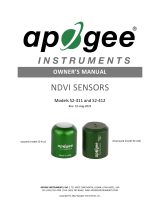 apogee INSTRUMENTS S2-411-SS Owner's manual
apogee INSTRUMENTS S2-411-SS Owner's manual
-
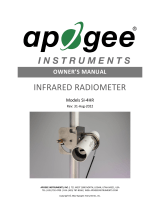 apogee INSTRUMENTS SI-4HR-SS Owner's manual
apogee INSTRUMENTS SI-4HR-SS Owner's manual
-
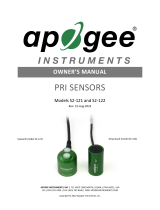 apogee INSTRUMENTS S2-121-SS Owner's manual
apogee INSTRUMENTS S2-121-SS Owner's manual
-
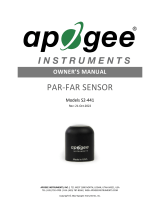 apogee INSTRUMENTS S2-441-SS Owner's manual
apogee INSTRUMENTS S2-441-SS Owner's manual
-
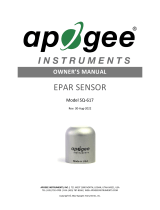 apogee INSTRUMENTS SQ-617-SS Owner's manual
apogee INSTRUMENTS SQ-617-SS Owner's manual
-
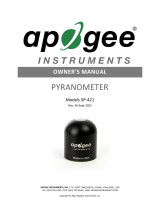 apogee INSTRUMENTS SP-421-SS Owner's manual
apogee INSTRUMENTS SP-421-SS Owner's manual
-
apogee INSTRUMENTS SF-421 Owner's manual
-
apogee INSTRUMENTS SF-421 Owner's manual
-
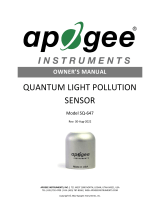 apogee INSTRUMENTS SQ-647-SS Owner's manual
apogee INSTRUMENTS SQ-647-SS Owner's manual
-
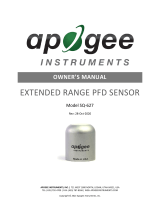 apogee INSTRUMENTS SQ-627-SS Owner's manual
apogee INSTRUMENTS SQ-627-SS Owner's manual
Other documents
-
Apogee SQ-421 QUANTUM SENSOR Owner's manual
-
Apogee SQ-617 Owner's manual
-
Apogee SI-4H1 Owner's manual
-
Apogee SQ-421X Owner's manual
-
Apogee SQ-610 EPAR SENSOR Owner's manual
-
Apogee SQ-614 Owner's manual
-
Apogee SO-421 User manual
-
Apogee SQ-614 Owner's manual
-
Apogee SQ-214 QUANTUM SENSOR Owner's manual
-
Apogee SQ-616 User manual




























